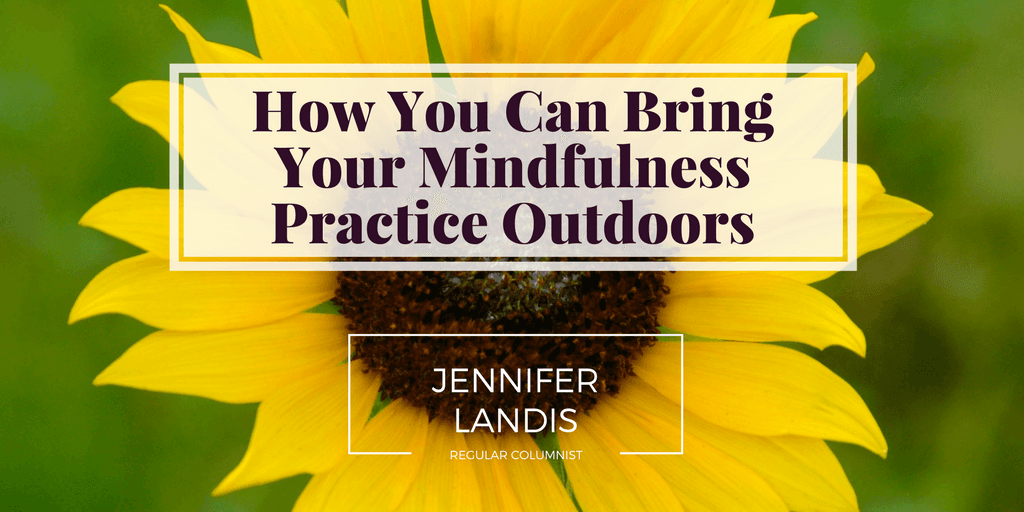I’m pleased and honored, as always, to host Jennifer Landis, author-owner of the wonderful blog Mindfulness Mama. While I love all of Jennifer’s posts, this one especially resonates with me. I’ve been interested in mindfulness for many years, but it’s only since Dave and I moved to Vermont that I’ve begun to fully appreciate the importance — and calming effects — of spending time in the natural world. As Jennifer points out: “You confront with objectivity what you can’t control and may embrace it with wonder as you see obstacles as opportunities.”
I hope you enjoy Jennifer’s post and find it as inspiring — and hopeful — as I do!
How You Can Bring Your Mindfulness Practice Outdoors
by Jennifer Landis
 Every day the world becomes more blandly concrete and less vivaciously green. Most Americans—and certainly most writers—spend these days indoors staring at four walls and plastic plants — in fact, 93 percent of life is spent indoors, with 87 percent in a building and 6 percent in cars — only 7 percent of life is spent outdoors. Out of a week, that’s half of a single day.
Every day the world becomes more blandly concrete and less vivaciously green. Most Americans—and certainly most writers—spend these days indoors staring at four walls and plastic plants — in fact, 93 percent of life is spent indoors, with 87 percent in a building and 6 percent in cars — only 7 percent of life is spent outdoors. Out of a week, that’s half of a single day.
Pretty sad, huh? Blanket burritos provide their comfort, and YouTube can give you the pleasant sound of a crackling fire whenever you want. Plus, you usually water your calla lily. Why go out, when you can bring nature in?
The winter brings out Seasonal Affective Disorder (SAD) in many people, but as the weather warms up to springtime, the energy to return outdoors and get active blooms. Regardless of weather conditions and location, spending more time connecting with the natural world opens the mind and heart to creative and expansive ways of seeing your life. You confront with objectivity what you can’t control and may embrace it with wonder as you see obstacles as opportunities—gaining inspiration and creative solutions to challenges you face in your writing.
Finding Inner Openness with a Mindful Outdoor Practice
 As you practice mindfulness, your heart and mind quieten in a busy and restless world where people wear endless masks and breathe in toxic fumes, words and behaviors. The natural world gifts you with more than rushing to try to achieve the status quo—and removes you from the stifling constraints you may sometimes feel at your desk. Here are five tips to help you embody, on the inside, the mindfulness in the natural world when you bring your practice outdoors.
As you practice mindfulness, your heart and mind quieten in a busy and restless world where people wear endless masks and breathe in toxic fumes, words and behaviors. The natural world gifts you with more than rushing to try to achieve the status quo—and removes you from the stifling constraints you may sometimes feel at your desk. Here are five tips to help you embody, on the inside, the mindfulness in the natural world when you bring your practice outdoors.
1. Read a Book Under a Tree
 When you sit on the step root of an old oak tree, eventually your feet sink into the Earth as roots themselves — you find yourself grounded in a new way. Let yourself sink into the story this way as the trunk of the tree supports you, and be transported. Admire how the paper allowed the writer to convey their story to you, just as the tree that paper is felled from now supports and shelters you.
When you sit on the step root of an old oak tree, eventually your feet sink into the Earth as roots themselves — you find yourself grounded in a new way. Let yourself sink into the story this way as the trunk of the tree supports you, and be transported. Admire how the paper allowed the writer to convey their story to you, just as the tree that paper is felled from now supports and shelters you.
Or bring your notebook or writer’s journal to that same step, let your feet take root, and sink into your own story, allowing your words to transport you. Feel your connection expanding, reaching out to your readers.
2. Go Earthing
 Find a patch of clean soil and refresh your soul by letting the soles of your feet wander barefoot in the dirt. Squish the Earth between your toes — you’re going earthing.
Find a patch of clean soil and refresh your soul by letting the soles of your feet wander barefoot in the dirt. Squish the Earth between your toes — you’re going earthing.
Going earthing sounds new-agey and a little too symbolic to have scientific merit, but it does. Scientific research backs up the fact that the Earth’s electrons cause many psychological changes – which are clinically significant when people “earth” — such as better sleep, blood-thinning and reduced pain. Earthing, or grounding, places you into contact with the planet’s surface electrons as you walk barefoot and the ground’s energy transfers to the body.
3. Forest Bathe
 Forest bathing is essentially a fancy term for taking a mindful walk in the woods, but with much more substance. In the 1990s, the Japanese Ministry of Agriculture, Forestry and Fisheries created the definition Shinrin-yoku for “forest bathing,” in which people slow down and immerse themselves in nature. They wander mindfully through the woods with no route strictly in mind and let nature do the rest.
Forest bathing is essentially a fancy term for taking a mindful walk in the woods, but with much more substance. In the 1990s, the Japanese Ministry of Agriculture, Forestry and Fisheries created the definition Shinrin-yoku for “forest bathing,” in which people slow down and immerse themselves in nature. They wander mindfully through the woods with no route strictly in mind and let nature do the rest.
When you calm your mind and center, you see details about the world you didn’t before. The research compared walking in portions of nature surrounded by the city to walking in a forest, and the latter had more significant health benefits, such as a reduction in particular stress hormones and blood pressure. Forest bathing is a mini mindfulness retreat you can do during a half day to reap all the whole body and mind health benefits.
4. Compost
 About 40 percent of U.S.-produced food goes to waste, even though scraping a few leftover bites off your plate and into the garbage doesn’t feel like much. Imagine how it adds up in your household, neighborhood, zip code, city, state and finally, the entire country. Composting instead of throwing away your food into the landfill nurtures the Earth and may reduce your garbage bill. The basic steps to composting include finding an open place of ground without plants and grass to allow organisms and worms to help aerate the compost. Twigs make a useful cover when you lay your first pile, which should be a few inches deep. Each successive layer should shift between moist and wet – for example, food scraps then wood, tea bags then straw and seaweed then cardboard. Green manure adds nitrogen, such as grass clips, to speed the composting process. Finally, you water the pile to keep it moist and keep it covered and turning.
About 40 percent of U.S.-produced food goes to waste, even though scraping a few leftover bites off your plate and into the garbage doesn’t feel like much. Imagine how it adds up in your household, neighborhood, zip code, city, state and finally, the entire country. Composting instead of throwing away your food into the landfill nurtures the Earth and may reduce your garbage bill. The basic steps to composting include finding an open place of ground without plants and grass to allow organisms and worms to help aerate the compost. Twigs make a useful cover when you lay your first pile, which should be a few inches deep. Each successive layer should shift between moist and wet – for example, food scraps then wood, tea bags then straw and seaweed then cardboard. Green manure adds nitrogen, such as grass clips, to speed the composting process. Finally, you water the pile to keep it moist and keep it covered and turning.
5. Feed the Birds, Butterflies and Bees
 Nurture nature’s pollinators by feeding the birds, butterflies and bees. Hang bird seed feeders in the trees and from your porch. Start a butterfly and bee garden full of useful plants that are pollen- and nectar-rich, such as bee balm, milkweed and calendula. Nesting boxes also provide shelter from bad weather and predators.
Nurture nature’s pollinators by feeding the birds, butterflies and bees. Hang bird seed feeders in the trees and from your porch. Start a butterfly and bee garden full of useful plants that are pollen- and nectar-rich, such as bee balm, milkweed and calendula. Nesting boxes also provide shelter from bad weather and predators.
Feel the warmth of being a caregiver of nature swell within you as you feed these beautiful creatures. What can you learn from them as you watch them? How can you apply these lessons from the natural world to your work?
Time in Nature Boosts Health and Happiness
As we know, stress and fatigue are the mortal enemies of creative thinking and writing. While research reveals looking at images of nature boosts the energy levels of workers, experiencing the real deal outside provides even more potent benefits. Your mind and heart open up, and your stress and blood pressure levels drop.
 So, unwrap your SAD self from your blanket burrito, peel off your fuzzy bunny bedroom slippers and get outside. Go earthing. Bathe in the forest. Start a compost pile. Read a book under a big tree. Feed the birds, butterflies and bees.
So, unwrap your SAD self from your blanket burrito, peel off your fuzzy bunny bedroom slippers and get outside. Go earthing. Bathe in the forest. Start a compost pile. Read a book under a big tree. Feed the birds, butterflies and bees.
Do a hippy dance whenever the others judge you from their four-walled boxes of boredom. Watch how your mindful view of the outdoors transforms your inner life and perception of control, and quiets your mind, inviting the free flow of ideas, expanding your creativity, and encouraging and enhancing connections. The world—and quite likely your work—just got more interesting thanks to green thumbs and dirty toes. Now, go dig in!
About Jennifer Landis
 Jennifer Landis is a mom, wife, and healthy living blogger at Mindfulness Mama. She loves yoga, distance running, peanut butter, and spending the small amount of free time she has watching Netflix with her husband.
Jennifer Landis is a mom, wife, and healthy living blogger at Mindfulness Mama. She loves yoga, distance running, peanut butter, and spending the small amount of free time she has watching Netflix with her husband.




I'd love to hear your thoughts!